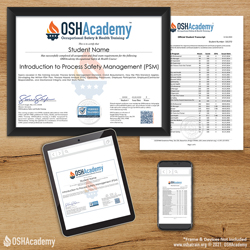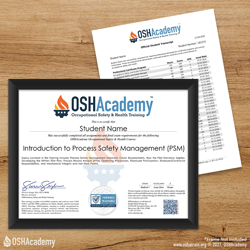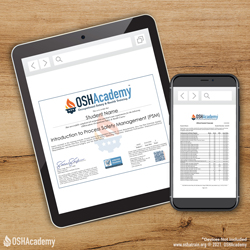Introduction
The major purpose of process safety management (PSM) of highly hazardous chemicals is to prevent unwanted released of hazardous chemicals, especially into locations that could expose employees and others to serious hazards. This course is intended to introduce students to the basic requirements in the PSM standard, the need for process safety, and the tools used to implement process safety management systems. It covers the 14 elements required by the standard and some of the tools used to address process safety requirements, identify hazards, and manage risks.
Retraining: The retraining requirement for PSM in 1910.119(g)(2) applies only to employees "...involved in operating a process to assure that the employee understands and adheres to the current operating procedures of the process. The employer, in consultation with the employees involved in operating the process, shall determine the appropriate frequency of refresher training." Employees are not required to retake this introductory awareness-level course in PSM every three years.
Course Objectives
| ID | Objective |
|---|---|
| TO 1.0 | Achieve a minimum score of 70% on the final course assessment. |
| LO 1.1.1 | Summarize the requirements in 29 CFR 1910,119, Process Safety Management of Highly Hazardous Chemicals, and Section 304 of the Clean Air Act Amendments (CAAA). |
| LO 1.2.1 | Describe OSHA's definition of "process" and give an example of a simple process. |
| LO 1.3.1 | Identify and describe each of the 14 elements of the written Process Safety Management (PSM) Plan. |
| LO 1.4.1 | Describe the purpose of and the steps used in conducting a Process Hazard Analysis (PHA). |
| LO 1.5.1 | Identify the elements and describe PSM operating procedure requirements. |
| LO 1.6.1 | Discuss employer responsibilities to ensure employees participate in PSM process, plan development, and training. |
| LO 1.7.1 | Discuss employer, employee, and contractor responsibilities under the PSM program. |
| LO 1.8.1 | Define "mechanical integrity" and "hot work," and how they apply to PSM. |
| LO 1.9.1 | Describe the importance of management of change (MOC), emergency response, and trade secrets. |
Key: Terminal Objective (TO), Learning Objective (LO)



